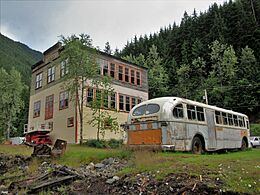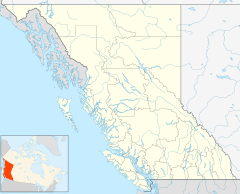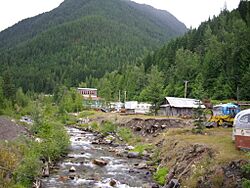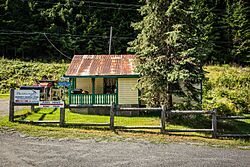Sandon, British Columbia facts for kids
Quick facts for kids
Sandon
|
|
|---|---|

Trolleybus beside a building in Sandon
|
|
| Country | |
| Province | BC/BCE |
| Region | Slocan Valley, West Kootenay |
| Regional district | Central Kootenay |
| Incorporated | January 1, 1898 |
| Elevation | 1,060 m (3,480 ft) |
| Population
(2016)
|
|
| • Total | 6 |
| Area codes | 250, 778, 236, & 672 |
Sandon is a historic place in the West Kootenay region of southeastern British Columbia, Canada. It sits in the foothills of the Selkirk Mountains. This nearly empty town, often called a ghost town, is located off BC Highway 31A. It is where Sandon Creek flows into Carpenter Creek. By road, Sandon is about 14 kilometers (9 miles) east of New Denver and 43 kilometers (27 miles) west of Kaslo.
Contents
Where Did Sandon Get Its Name?
The town of Sandon gets its name from Sandon Creek. This creek was named after John Sandon. He was one of many prospectors who came to the Slocan Valley in 1891. John Sandon claimed several pieces of land, including the "Slocan Star" mining claim. This claim was located on Sandon Creek.
John Sandon and his partner, Bruce White, also claimed land where the creek met another body of water. John Sandon later sold his share of the Slocan Star to White for $500. This property became very valuable. John Sandon also had a vegetable farm, growing potatoes to feed the nearby mining camps.
How Sandon Started
In July 1893, Robert E. Lemon, a well-known merchant, planned out the town of Sandon. Later, Lemon Creek was named after him. In December 1895, another person named John Morgan Harris added more land to the town. Other areas like East Sandon, Sunnyside, and West Sandon were added later.
John Morgan Harris owned many buildings in Sandon. These included hotels, offices, the power plant, and water systems. Sandon became known as the "Monte Carlo of North America" because it had so many fun places. It had many hotels and even three breweries.
Sandon officially became a city on January 1, 1898. During the mining boom of the 1890s, Sandon had everything a modern town needed. It had a large curling arena, a hockey rink, and two ski hills. People could also play lacrosse, soccer, baseball, lawn bowling, cricket, and tennis. Inside, there were bowling alleys, billiard halls, and a gym.
Sandon was the first town in British Columbia to have electricity everywhere. The Silversmith Powerhouse, built in 1897, was the second hydroelectricity plant in Western Canada. It is still the oldest power producer in Western Canada that has been running continuously.
Trains and Railways
Two different railway companies raced to reach Sandon first. The Kaslo & Slocan Railway, owned by the Great Northern Railway, connected Sandon to Kaslo. Kaslo is on Kootenay Lake. The other railway was the Nakusp & Slocan Railway, owned by the Canadian Pacific Railway. This line connected Sandon to Nakusp on the Upper Arrow Lake. It also connected to the Slocan Lake ferry at Rosebery.
When the railways arrived in 1895, the competition between them became very strong. The last passenger train ran in 1933. In 1955, floods on Carpenter Creek caused a lot of damage. This stopped all train traffic to Sandon forever.
Silver Mining in Sandon
In 1891, Eli Carpenter and Jack Seaton discovered silver in the area. After this, thousands of prospectors came looking for rich deposits of silver-lead ore. From 1892 to 1900, Sandon's silver mines were the richest in British Columbia.
Mining slowed down for a while, but World War I brought the most productive mining period. In the early 1950s, during the Korean War, silver prices went up. This brought mining back for a short time, but it ended in 1953. The Silvana Mine operated later but closed in 1993.
Why Sandon Became a Ghost Town
In May 1900, a large fire started and destroyed most of Sandon's downtown area. The buildings were rebuilt, but they were not as grand. Still, the town saw short periods of mining success again. In 1907, a large avalanche caused a lot of damage.
In 1920, the city faced financial problems and stopped being an official city. Without local taxes, the town's buildings and services got worse. After 1953, large-scale mining never returned. John Morgan Harris, who had once owned so much of the town, died that year without much money.
In June 1955, heavy rain caused Carpenter Creek to overflow. This flood destroyed most of the buildings that were left. After the flood, people looking for treasures and vandals took what remained. They then moved on to other nearby ghost towns.
Japanese Canadian Internment
During World War II, Sandon was one of the places where Japanese Canadians were sent. These people were moved from the BC coast by the government. About 953 Japanese Canadians lived peacefully with the 50 residents of Sandon at the time. They used and helped fix up the old, empty buildings. However, the harsh winters made the camp close early. The internees were then moved to New Denver.
Sandon Today
Today, a few people still live in Sandon, and some newcomers have joined them. They are working hard to save what is left of the town. Hal Wright arrived in the 1970s and became the unofficial caretaker. He has bought much of the empty land from the government. He also works with volunteers to save old buildings. These include the city hall, the Silversmith Powerhouse, and some original homes.
The restored Slocan Mercantile General Store is now a protected heritage site. Sandon attracts over 60,000 visitors each year.
One of the biggest attractions is a collection of about 20 old Brill trolleybuses. These buses were shipped from Vancouver in the early 2000s. Some of them were even used by Calgary Transit before being sold to BC Transit. There are plans to create a proper heritage site, but they need more funding from the province. For now, volunteers and visitor donations help keep Sandon's history alive. In 2018, the community hosted a music festival called "Valley of the Ghosts."
Sandon on TV
Sandon was shown on a historical television series called Gold Trails and Ghost Towns. It was in the first episode of Season 1.
Famous People from Sandon
Cecil "Tiny" Thompson, a famous hockey player who is in the Hockey Hall of Fame, was born in Sandon.




